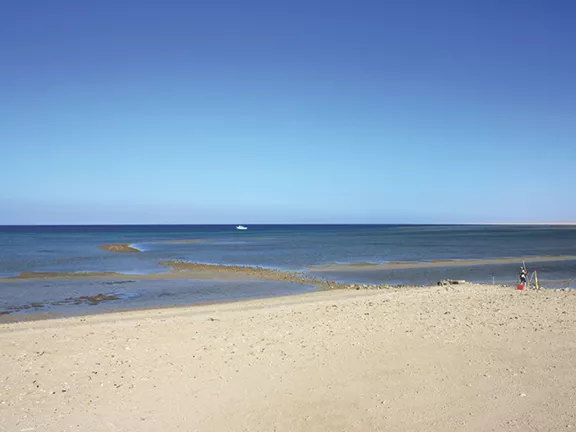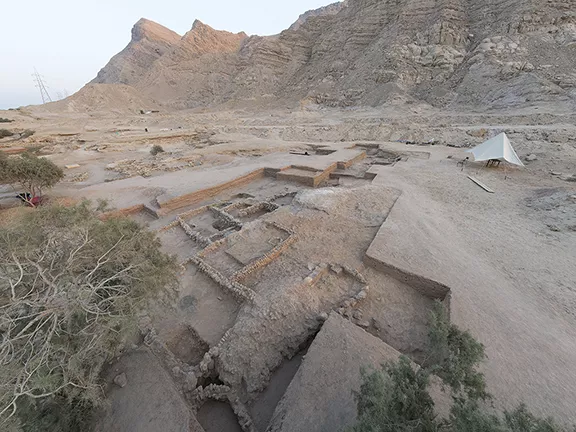Ancient Mediterranean Shipyards and Harbours
Dana Island: Turkey's Iron Age Shipyard and Ancient Naval Base
The archaeological discoveries on Dana Island, located off the coast of Rough Cilicia (modern-day southern Turkey), have revealed what is considered the largest and potentially oldest ancient shipyard in the Mediterranean, with significant evidence dating back to the Iron Age.
By Nick Nutter on 2025-09-5 | Last Updated 2025-09-5 | Ancient Mediterranean Shipyards and Harbours
This article has been visited 1,207 times

Aerial view of the Dana Island shipyards
Dana Island: Turkey’s Iron Age shipyard 800 BC – 700 AD
Underwater investigations and surface surveys on Dana Island have uncovered an astonishing number of nearly 300 rock-cut slipways. This is the largest concentration of ancient naval installations discovered to date, far surpassing other known sites. This vast number suggests a capacity for simultaneous shipbuilding and maintenance on an unprecedented scale in the ancient world.
Do you enjoy my articles? For your reading pleasure, this website does not carry third party ads. You could help me write more articles by buying me a cup of coffee.
When was the Dana Island shipyard discovered?
The shipyard was discovered in 2015 by a team of underwater archaeologists from Selcuk University in Turkey, but its full extent was only recently realized after years of underwater surveys and excavations. The excavations and research are being coordinated by Associate Professor Dr. Hakan Oniz, the head of Selkuk University's Underwater Archaeology Department.
Where is Dana Island?
The ruins of the shipyard were found in the north of the island of Dana, located along the coastline of the Silifke district of Mersin province in the Mediterranean region of Turkey.
Description of the Dana Island shipyard


Artist's impression of the Dana Island shipyard - Credit Greek Reporter
The discovery of approximately 294 rock-cut slipways/shipsheds on Dana Island, dating from the 8th Century BC to the 7th Century AD, represents an ancient shipyard of unparalleled size, surpassing famous naval installations like Athens or Carthage. The slipways exhibit different characteristics, types, and sizes, indicating the use of diverse slipping techniques across various periods. The slipways vary considerably in size and characteristics, indicating they could accommodate a range of vessels, from smaller boats to large warships. This suggests a versatile shipbuilding and maintenance facility capable of supporting a substantial fleet.
Behind the slipways, archaeologists have identified various structures interpreted as workshops used in shipbuilding, as well as living spaces, military and religious buildings, managerial facilities, and cisterns for water supply. This indicates a comprehensive naval base and shipyard complex, not just simple slipways.
Capacity for Various Vessel Sizes
The shipyard could accommodate the construction and maintenance of a wide range of vessels. Researchers estimate that users could construct ships up to 40 metres in length.
- There are 27 small boat ramps for 4–7 metre boats.
- 133 small-sized slipways (4–5 metres wide, 8–13 metres long).
- 86 medium-sized slipways (5–7 metres wide, 14–20 metres long).
- 48 large-sized slipways (7–12 metres wide, 21–34 metres long).
Diverse Hauling and Launching Techniques
Observations from Dana Island suggest that almost all known hauling techniques in the Mediterranean may have been employed here. Evidence includes:
Slipping and Launching Cradles: Ships were positioned on cradles (Vazo-Vazia) at sea and then hauled along rock-cut channels (two runners per cradle) inside the slipway. Some slipways have grooves to secure the cradle and ship, while others feature two or even three channels (one keel slot and two cradle runners). Animal power, such as oxen, may have been used for hauling, as indicated by structures interpreted as animal shelters.
Fixed Timber Constructions: A method where ships in cradles were slid through a fixed timber structure built on the slipway, a practice that continued into the early twentieth century on the Anatolian coast.
Direct Hauling on Greased Slipways: Many slipways show no keel slot or cradle runners, suggesting ships could be hauled directly over the greased slipway surface. Some of these still featured grooves for the forward end of the cradle and the ship's bow.
Sliding on Own Keels: Vessels could be slid on their own keels over a dedicated keel slot (central runner).
Cylindrical Logs: Smaller ships may have been hauled over cylindrical logs, a quicker but more labour-intensive process still in use today in the Eastern Mediterranean.
Specialised Small Rock-Cut Structures: Unique structures, often found between or behind larger slipways, are believed to be for smaller boats, possibly tenders to mother ships. These structures imply that maintenance of both the ship and tender could be carried out simultaneously. They typically had a rock-cut structure for the front of the boat and relied on wooden posts for support of the lower middle and rear parts.
Associated Infrastructure
Beyond the slipways, the shipyard included extensive support facilities such as workshops, mills, barracks, produce barns, five churches, a bath, and 221 cisterns, predominantly dated from the 5th Century BC to the 6th Century AD. The construction leveraged the soft, workable eolianite (grès dunaire) limestone, which was ideal for large-scale cuttings.
Continuing Research
Archaeological work, including underwater surveys and 3D modelling, continues on Dana Island to further understand the chronology, function, and significance of this extraordinary ancient shipyard. Recent discoveries include evidence of specialized construction for smaller vessels behind the larger slipways.
When was the Dana Island shipyard in operation?
While the shipyard was likely used in later periods as well, the architectural forms of some of the structures show resemblances to Iron Age masonry, leading archaeologists to believe a significant phase of its use dates back to, perhaps, 1200 BC. However, the confirmed evidence to date is that the shipyard was in use from about 800 BC until about 700 AD. This is a particularly significant finding as archaeological evidence from the Mediterranean "Dark Ages" (following the Bronze Age collapse) is relatively scarce. The Dana Island shipyard provides crucial insights into the maritime capabilities of this era.
Dana Island's location in Rough Cilicia, with access to cedar trees in the Taurus Mountains (essential for shipbuilding) and iron ore deposits, made it a strategic location for maritime activities and trade from the Bronze Age onwards.
Significance of the Dana Island Shipyard
Some scholars suggest that ships built on Dana Island may have played a role in major sea battles of antiquity, including conflicts involving the Sea Peoples during the Bronze Age and later engagements between Greeks and Persians. The sheer capacity of the shipyard to produce a large number of warships would have had significant political, military, and commercial implications for the Mediterranean.
The shipyard on Dana Island is considered remarkably well-preserved and untouched, offering a unique opportunity to study ancient shipbuilding technology and naval organization.
The Iron Age shipyards discovered on Dana Island represent a groundbreaking discovery in maritime archaeology. Their scale, potential age, and associated infrastructure provide invaluable insights into the naval capabilities and maritime history of the Iron Age Mediterranean, a period that was previously less understood. The site underscores the importance of naval power in the ancient world and the sophisticated logistical operations required to build and maintain large fleets.
The continuous occupation of Dana Island from the 8th Century BC to the 7th Century AD highlights the ongoing need for ship construction and maintenance. The threat from wood-boring worms like Teredo navalis in the Mediterranean necessitated frequent hauling out of wooden vessels for servicing.
References
The information about the Dana Island shipyards largely comes from the archaeological work of Professor Hakan Öniz and his team from Akdeniz University in Turkey, as well as collaborative research.
Hakan Öniz, ed. Dana Island: The Greatest Shipyard of the Ancient Mediterranean. Archaeopress Publishing, 2021.
This is a comprehensive volume that details the archaeological discoveries, analysis of the slipways, their use, dating, and the associated structures on the island. It is considered the definitive work on the subject and includes contributions from other scholars.
Öniz, Hakan. "Dana Island Ancient Shipyard, Rough Cilicia: Archaeological Observations."
Denker, A., and H. Öniz. "Ancient Shipyard on Turkey's Dana Island: Its 3D Modelling with Photogrammetry and Computer Graphics." The International Archives of the Photogrammetry, Remote Sensing and Spatial Information Sciences XLII-2, 2018, pp. 289–296.
Höckmann, O., and H. Öniz. "Ancient Shipsheds on Dana Island: Some Preliminary Observations."
Öniz and Büyükkol, "Rock-Cut Slipways and Slipping Techniques at Dana Island Shipyard," Journal of Maritime Archaeology 2024
Do you enjoy my articles? For your reading pleasure, this website does not carry third party ads. You could help me write more articles by buying me a cup of coffee.
 1: Egypt's Wadi al-Jarf c 2600 - 2560 BC
1: Egypt's Wadi al-Jarf c 2600 - 2560 BC 2: Egypt's Ro-She Khufu 2580 - 2500 BC
2: Egypt's Ro-She Khufu 2580 - 2500 BC 3: Egypt's Ayn Soukhna c 2500 - 1850 BC
3: Egypt's Ayn Soukhna c 2500 - 1850 BC 4: Egypt's Mersa/Wadi Gawasis c 2000 - 1500 BC
4: Egypt's Mersa/Wadi Gawasis c 2000 - 1500 BC